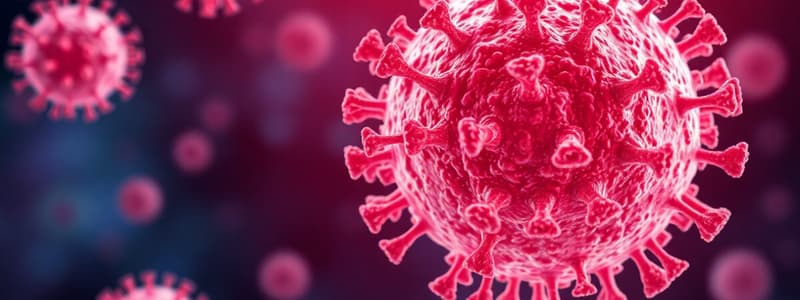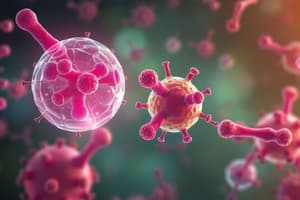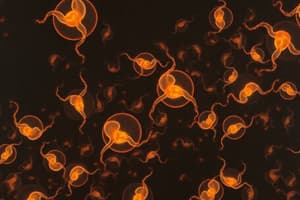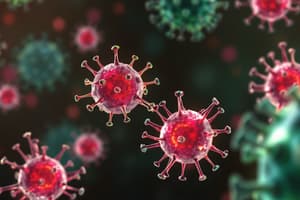Podcast
Questions and Answers
Which of the following is a key attribute of adaptive immunity?
Which of the following is a key attribute of adaptive immunity?
- Inability to target specific invaders
- Lack of specificity in recognizing antigens
- Immediate response at birth
- Memory to the same antigens (correct)
Which type of lymphocyte is primarily involved in humoral immunity?
Which type of lymphocyte is primarily involved in humoral immunity?
- Natural killer cells
- B lymphocytes (B cells) (correct)
- Macrophages
- T lymphocytes (T cells)
What is the primary role of T lymphocytes (T cells) in adaptive immunity?
What is the primary role of T lymphocytes (T cells) in adaptive immunity?
- Producing antibodies to neutralize pathogens
- Activating the complement system
- Directly attacking and killing infected cells (correct)
- Acting as antigen-presenting cells
Which of the following best describes antigens?
Which of the following best describes antigens?
What is the origin of endogenous antigens?
What is the origin of endogenous antigens?
What are epitopes?
What are epitopes?
What is the function of Major Histocompatibility Complexes (MHC)?
What is the function of Major Histocompatibility Complexes (MHC)?
What types of cells express MHC I?
What types of cells express MHC I?
Which of the following cell types can function as antigen-presenting cells (APCs)?
Which of the following cell types can function as antigen-presenting cells (APCs)?
If an antigen-presenting cell (APC) is presenting an antigen, which MHC class(es) would it use?
If an antigen-presenting cell (APC) is presenting an antigen, which MHC class(es) would it use?
Where are MHC I molecules typically found?
Where are MHC I molecules typically found?
What surface receptor is unique to T cells and recognizes pathogen epitopes?
What surface receptor is unique to T cells and recognizes pathogen epitopes?
What is the role of costimulation in the activation of T and B cells?
What is the role of costimulation in the activation of T and B cells?
Interleukins (ILs) belong to which group of immune mediators?
Interleukins (ILs) belong to which group of immune mediators?
What is the primary function of cytotoxic T lymphocytes (Tc) or (T8)?
What is the primary function of cytotoxic T lymphocytes (Tc) or (T8)?
What is the purpose of regulatory T lymphocytes?
What is the purpose of regulatory T lymphocytes?
How do infected cells contribute to T cell activation?
How do infected cells contribute to T cell activation?
Plasma cells are direct descendants of which type of cell?
Plasma cells are direct descendants of which type of cell?
What is the role of Helper T lymphocytes (T4, Th) in B cell activation?
What is the role of Helper T lymphocytes (T4, Th) in B cell activation?
What is the most common and longest-lasting antibody?
What is the most common and longest-lasting antibody?
Which antibody is associated with body secretions?
Which antibody is associated with body secretions?
Which class of antibody is primarily involved in responses to parasitic infections and allergies?
Which class of antibody is primarily involved in responses to parasitic infections and allergies?
What is the direct effect of antibodies on microbes?
What is the direct effect of antibodies on microbes?
Which mechanisms involves the attachment of microbes together by antibodies?
Which mechanisms involves the attachment of microbes together by antibodies?
What is one method of obtaining memory against a specific epitope?
What is one method of obtaining memory against a specific epitope?
Flashcards
Adaptive Immunity
Adaptive Immunity
Body's ability to recognize and defend itself against specific invaders and their products.
Antigens
Antigens
Molecules recognized as foreign and worthy of attack.
Epitopes
Epitopes
The three-dimensional regions on antigens that are recognized by the immune system.
Major Histocompatibility Complexes (MHC)
Major Histocompatibility Complexes (MHC)
Signup and view all the flashcards
Antigen Presenting Cell (APC)
Antigen Presenting Cell (APC)
Signup and view all the flashcards
T Cell Receptor (TCR)
T Cell Receptor (TCR)
Signup and view all the flashcards
B Cell Receptor (BCR)
B Cell Receptor (BCR)
Signup and view all the flashcards
Costimulation
Costimulation
Signup and view all the flashcards
Cytokines
Cytokines
Signup and view all the flashcards
T lymphocytes (T cells)
T lymphocytes (T cells)
Signup and view all the flashcards
B lymphocytes (B cells)
B lymphocytes (B cells)
Signup and view all the flashcards
Exogenous antigens
Exogenous antigens
Signup and view all the flashcards
Endogenous antigens
Endogenous antigens
Signup and view all the flashcards
Autoantigens
Autoantigens
Signup and view all the flashcards
Major histocompatibility complexes
Major histocompatibility complexes
Signup and view all the flashcards
Cell mediated
Cell mediated
Signup and view all the flashcards
IgM
IgM
Signup and view all the flashcards
IgG
IgG
Signup and view all the flashcards
IgA
IgA
Signup and view all the flashcards
IgE
IgE
Signup and view all the flashcards
IgD
IgD
Signup and view all the flashcards
AntibodyEffect
AntibodyEffect
Signup and view all the flashcards
Cytotoxic T lymphocyte (T8, Tc)
Cytotoxic T lymphocyte (T8, Tc)
Signup and view all the flashcards
Regulatory T
Regulatory T
Signup and view all the flashcards
Helper T lymphocyte (T4, Th)
Helper T lymphocyte (T4, Th)
Signup and view all the flashcards
Study Notes
- Chapter 16 is about Adaptive Immunity
Overview of Adaptive Immunity
- Adaptive immunity involves recognizing and defending against specific invaders and their products
- Adaptive immunity is also known as "detective" immunity
- Attributes include specificity, memory, and a delayed functional start
Lymphocytes
- Lymphocytes are crucial for adaptive immunity
- The two main types are B lymphocytes (B cells) and T lymphocytes (T cells)
B Lymphocytes (B Cells)
- B lymphocytes mediate humoral immunity by attacking invaders outside the cell
- Function against Extracellular pathogens and toxins
T Lymphocytes (T Cells)
- T lymphocytes mediate cell-mediated immunity, attacking infected cells inside
- Function against Intracellular pathogens
Antigens
- Both T and B cells recognize antigens
- Antigens are molecules like surface proteins, carbs, or lipids recognized as foreign
- Antigens are the primary molecule the body recognizes
- There are 3 basic types of antigens
Exogenous Antigens
- Exogenous antigens are found outside a body’s cells
- Examples are toxins and components of microbial cell walls, membranes, flagella, and pili
Endogenous Antigens
- Endogenous antigens are produced by microbes that reproduce inside a body's cells
Autoantigens
- Autoantigens are self-made antigens made by our DNA
Epitopes
- Antigens are recognized by three-dimensional regions called epitopes
Major Histocompatibility Complexes (MHC)
- Epitopes are recognized by lymphocytes when displayed as Major Histocompatibility Complexes (MHC)
- MHCs are glycoproteins found in the membranes of most cells
- They hold and position epitopes for presentation to immune cells
Antigen Presenting Cell (APC)
- The cell that presents the antigen to the lymphocytes
MHC Proteins
- There are two types of MHC proteins
MHC I
- MHC I is present on all nucleated cells, except red blood cells
MHC II
- MHC II is present on antigen-presenting cells (APCs)
- APCs include macrophages, dendritic cells, and B cells
- APC's wander around and are non-stationary
- H cells could be both MHC I and MHC II
Antigen Processing
- Autoantigens are displayed as self MHC's
- Endogenous and Exogenous Antigens are processed into MHC proteins to display the pathogen epitopes
Cell Antigen Processing
- MHC I is used if a nucleated cell is fixed
- MHC I and MHC II are used when an antigen-presenting cell is involved
T Cell Receptor (TCR)
- T cells recognize pathogens displayed on MHCs
- T cells have a unique T Cell Receptor (TCR) protein for each pathogen epitope
- There is a matching TCR for every possible epitope
B Cell Receptors (BCR)
- B cells recognize pathogens displayed on MHCs
- B cells have unique B Cell Receptors (BCR) for pathogen epitopes
- Divisions of T and B cells occur after epitope recognition
Recognition
- Antigen Presenting Cells (APCs) are usually required for recognition
- APCs include macrophages, B cells, and dendritic cells
Costimulation
- Interaction between T/B cells and APCs is required to multiply T/B cells
- This interaction results in the release of surface molecules on each cell and Cytokines
Immune Response Cytokines
- Interleukins (ILs) signal among leukocytes to help communication between WBCs
Outcomes
- Recognition and costimulation lead to mass production of T/B cells to attack foreign epitopes
T Cell Activation
- T cell activation is a cell-mediated attack of infected cells
T Lymphocytes
- Types of T lymphocytes include Cytotoxic T lymphocytes, Helper T lymphocytes, Memory T lymphocytes and Regulatory T lymphocytes
Cytotoxic T Lymphocyte (T8, Tc)
- T8s, Tc, do the actual killing of cells and directly kill other cells with perforins
Helper T Lymphocyte
- Helper Ts help make the army and multiply B cells and cytotoxic T cells
- There are two types, type 1 (Th1) and type 2 (Th2)
Memory T Lymphocytes
- Memory T lymphocytes are used to remember the same epitope in the future
Regulatory T Lymphocyte
- Regulatory T lymphocyte involved w/ Autoimmune diseases and prevents self-attack
- Inhibits autoantigen attack
Important points for T Cells
- Infected cells display MHC I foreign epitopes
- APC displays both MHC I and MHC II
- Interleukin 12 is produced by the APC causing Th to become Th1
- Interleukin 2 is produced by both Th1 and Tc
- Tc now attacks infected Cells displaying MHC1 endogenous
B Cell Activation and Humoral Immunity
- Involves production of ANTIBODIES to attack extracellular epitopes
B Lymphocytes
- Initially recognize foreign epitopes and act as APC,s and become plasma cells
Plasma Cells
- Plasma cells produce antibodies
- Activated Helper T lymphocytes (T4, Th): help multiply B cells and cytotoxic T cells
Memory B lymphocytes
- The function of Memory B lymphocytes is, to remember the same epitope in the future so you wont get the same infection Again
Important points for B cells
- APC’s (both dendritic and B) displays MHC II
- Interleukin 4 causes Th to become Th2
- Interleukin 4 also causes B cell to become Plasma cells
- Antibodies from Plasma Cells attack exogenous antigens
Basic Antibody Structure
- Antibodies have 2 heavy chains and 2 light chains
- Each chain has a variable region that creates an Antigen Binding Site
- The site is epitope-specific
- The stem of the heavy chains leads to different types of antibodies
Antibodies
- IgM is the first antibody produced (acute)
- IgG is the most common and longest-lasting (chronic)
- IgA is associated with body secretions (mucous memb)
- IgE is involved in response to parasitic infections and allergies
- IgD exact function is not known
- Ig = immunoglobulin
Antibodies Actions
- Phagocytosis
- Lysis
- Agglutination (Clumping) - attaches microbes together
- Neutralize
- Antibodies don't kill microbes, they merely assist to get them killed
Vaccination
- One method of obtaining memory against a specific epitope is to Vaccinate
Studying That Suits You
Use AI to generate personalized quizzes and flashcards to suit your learning preferences.




